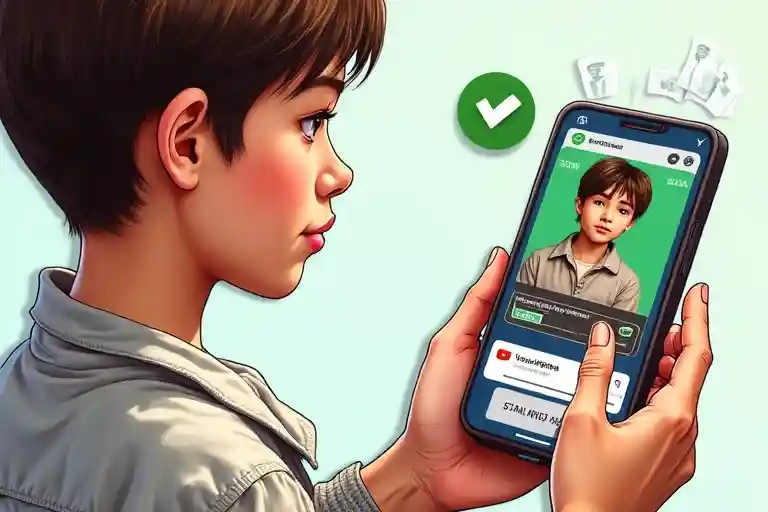Last updated: May 2025
Alright, so you’re probably scrolling through TikTok or YouTube, seeing people flash cash, and thinking, “How can I get a piece of that action?” And then you stumble upon it: the idea of **best paid to click sites**. The promise? Earn money just by clicking on ads. Sounds like a dream, right? Especially when you’re a teen looking for ways to make some extra bucks for that new game, those cool sneakers, or just some snacking money without having to beg your parents (again!). But hold up – is it really that simple? Can you actually make bank with **best paid to click sites**, or is it more like chasing digital pennies? Let’s dive deep and uncover the truth about these online platforms. We’re talking real talk, no fluff – what works, what definitely doesn’t, and how to keep yourself safe in the wild world of online earning. Because let’s be honest, nobody wants to end up in a “expectation vs. reality” meme that’s just…sad. We’ll explore some safe ways for teens to earn and figure out if this is one of them.
The Lowdown on best paid to click sites: What’s the Real Deal?
So, what exactly are these first-rate paid to click on websites everyone whispers about? Imagine a website that acts like a intermediary. Companies pay these websites to reveal their commercials to extra human beings (that’s you!). The PTC site then stocks a tiny, and I imply tiny, fraction of that cash with you whenever you click on on one of these advertisements and look at it for a few seconds. Think of it like this: you’re getting paid a few crumbs to your attention. It’s no longer a process inside the conventional sense; it’s extra like a micro-undertaking. You join up, browse a listing of to be had advertisements, click, await a timer (commonly five to 30 seconds), maybe clear up a captcha to show you’re human (and no longer a bot looking to cheat the device – excellent essential!), and cha-ching…a fraction of a cent lands in your account. It’s one of the ways people try to click and get paid on a site.
Now, why would anyone pay you for just looking at an ad? Advertisers want eyeballs on their products or services. They hope that by seeing their ad, you might become interested and eventually buy something. PTC sites offer them a cheap way to get a lot of views, even if the quality of those views (meaning, how likely someone is to actually buy) is debatable. The reality for you, the clicker, is that the earnings per click are incredibly low – we’re often talking fractions of a cent, like $0.001 to $0.01 per ad. So, if you’re dreaming of buying a new gaming console next week with your PTC earnings, you might need a reality check. It’s less “get rich quick” and more “get a tiny bit of pocket money verrrrry slowly.” Many wonder if PTC sites are worth it, and the answer often depends on your expectations and how much time you have.
How Do These Platforms *Actually* Work?
Let’s damage it down, step-via-step, like a TikTok educational, however for making (a touch little bit of) money. First, you discover a PTC website – and agree with me, there are tons out there, some professional-ish, many… now not so much. You sign on, typically without cost, via presenting an e-mail and growing a username and password. Important teenager tip #1: ALWAYS check if the website has an age restrict. Some are 18 , or even in the event that they can help you sign on, you may have hassle cashing out later in case you’re underage. And absolutely, DEFINITELY, chat along with your parents or a relied on grownup before signing up for something that includes getting cash on line. Their Spidey-senses for sketchy stuff are generally pretty right!
Once you’re in, you’ll see a dashboard, often with a section like “View Ads,” “Earn Money,” or “PTC Ads.” Clicking here will show you a list of available advertisements, each usually mentioning the (tiny) amount you’ll earn. You click an ad, a new tab opens, and you stare at it. Sometimes there’s a countdown timer. When it hits zero, you might need to click something or solve a simple puzzle (like matching an icon) to confirm you viewed it. That’s it! The micro-payment is added to your site account. Many of these are considered paying PTC sites that help you earn cash, but the key is *how much* cash and *how long* it takes.
The Different Ways to “Earn” on PTC Sites
While clicking ads is the main gig, some **best paid to click sites** offer a few other ways to bump up those earnings, though don’t expect them to be goldmines either. You might find options like:
- Paid Surveys: Sharing your opinion for a bit more than an ad click. These can be okay, but you often get screened out after answering a bunch of questions – major L.
- Micro Tasks/Offers: Things like signing up for other websites, downloading apps (be careful with this!), or watching videos. The pay varies, and so does the sketchiness level.
- Referral Programs: You get a unique link, and if your friends sign up through it, you earn a small percentage of what they earn. This sounds cool, but remember, they’ll also be earning pennies, so your cut will be… fractions of pennies. Not exactly influencer-level income.
- Playing Games: Some sites integrate super simple, ad-filled games. You play, they show you more ads, you earn a tiny bit.
The trick is that all these “methods” still revolve around you consuming ads or providing data, and the payout is almost always very low for the time invested. It’s a volume game, and often, the volume isn’t in your favor.
Best paid to click sites for free
Okay, let’s get one thing straight: pretty much all legitimate (and even many of the sketchy) **best paid to click sites** are free to join. If a PTC site asks you to pay a membership fee to start clicking ads and earning money, HUGE red flag! That’s like paying to get a job application for a minimum wage gig – it just doesn’t make sense. The whole model of these online earning sites is that *they* get paid by advertisers, and they pass a tiny slice to you. You are providing the service (your clicks, your eyeballs), so you shouldn’t be paying for the “privilege” of doing so.
When you’re looking for **best paid to click sites for free**, you’re essentially looking for standard PTC sites that don’t have upfront costs. The “free” part refers to joining, not necessarily that you’ll get rich for free. Your earnings come from the time and effort you put in. Think of it like this: your time is valuable. Even if joining is free, if you spend hours clicking for a dollar, is it *really* free? You’ve spent a valuable resource: your time! Always weigh the potential earnings against the time you’re sinking into it. Could you be using that time for homework, learning a new skill, or something more fun *and* potentially more profitable in the long run?
What to Look for in Free PTC Platforms
If you’re still curious and want to explore some **best paid to click sites for free**, here are a few things to keep an eye on to avoid the absolute duds:
- Clear Payout Threshold: How much do you need to earn before you can cash out? If it’s super high (like $50, when you earn $0.001 per click), you might click for literal years before seeing any money. Lower thresholds (e.g., $2-$5) are generally better.
- Payment Methods: Do they offer payment methods that work for you and are accessible to teens (with parental consent if needed)? PayPal is common, but some use cryptocurrencies or other online payment processors.
- User Reviews (with a grain of salt): See what others are saying online. But be wary – some reviews are fake, both positive and negative. Look for balanced reviews on reputable forums or review sites, not just the hype on their own page.
- Age of the Site: Generally, sites that have been around for a few years *might* be more stable, but it’s not a guarantee. New sites pop up and disappear all the time.
- Terms of Service & Privacy Policy: Yeah, I know, BORING. But a quick scan can tell you if they have weird rules or what they do with your data. If it’s confusing or seems off, maybe steer clear.
Remember, even the “best” free PTC sites are unlikely to make you significant money. Manage those expectations like you manage your screen time before bed – carefully!
Best paid to click sites for paypal
For many teens (and adults!), PayPal is the go-to for online transactions. It’s relatively easy to use, widely accepted, and generally considered secure. So, it makes sense you’d be looking for **best paid to click sites for paypal** payouts. When a PTC site offers PayPal, it can feel a bit more legitimate because PayPal has its own set of rules and verification processes for businesses. However, this isn’t a foolproof sign that a PTC site is amazing or will make you rich. It just means they have a PayPal account set up to send payments.
The good news is that many of the longer-standing PTC sites do offer PayPal as a withdrawal option. This is convenient because once the money is in your PayPal, you can often use it to shop online, send it to your bank (if you have one linked and are old enough, or with parental help), or for other digital purchases. Before you get too excited, though, always check the *minimum payout threshold* for PayPal. Some sites might have a higher threshold for PayPal withdrawals compared to other, perhaps less convenient, payment methods. This is something to consider if you want your ads click earn money website experience to actually result in cash you can use.
Why PayPal is Popular and What to Check
Why is PayPal a big deal for these kinds of online earning sites? For users, it’s familiar and trusted. You likely already have an account, or your parents do. For PTC sites, it’s a straightforward way to distribute small payments to a global user base. But here’s the kicker: transaction fees. PayPal charges fees, so sometimes the PTC site might deduct a small fee from your payout, or they might have a slightly higher minimum payout to make the transaction worthwhile for them. Always read the fine print in their “cashout” or “payments” section.
Also, ensure your PayPal account is in good standing and, if you’re under 18, that it’s set up correctly according to PayPal’s terms (often requiring parental involvement, like a student account linked to a parent’s account). Getting your PTC earnings stuck because of a PayPal account issue is a total bummer. And remember, even with **best paid to click sites for paypal**, the core issue remains: the earnings per click are very, VERY low. PayPal just makes it a bit easier to access those tiny earnings once you’ve accumulated enough.
Pay per click sites make money online – How do they *really* work?
So, you’ve heard that **pay per click sites make money online**, but how does the cash actually flow? It’s not magic! It’s a business model, though sometimes a shaky one. Think of it like a triangle:
- The Advertisers: These are businesses (big or small) that want to promote their products, services, or websites. They want traffic, and they’re willing to pay for it. They go to a PTC site and say, “Hey, I’ll pay you X amount for every person who views my ad.”
- The PTC Site (The Middleman): This is the platform you sign up for. They take the money from the advertisers. Their job is to gather an audience (that’s you and thousands of others!) willing to click on those ads. They display the ads and manage the system.
- You (The Clicker): You click on the ads. For each click and view that meets the PTC site’s criteria (like watching for a certain number of seconds), the PTC site gives you a *small portion* of the money they got from the advertiser.
The PTC site makes its profit from the difference between what the advertiser pays them and what they pay out to clickers like you. For example, an advertiser might pay the PTC site $0.02 per view, and the PTC site might pay you $0.002. The PTC site pockets the $0.018. It doesn’t sound like much, but multiply that by thousands of clickers and thousands of ads, and it can add up for the PTC site owner.
The critical part for you, the teen trying to make some quick money online, is that your slice of the pie is always going to be the smallest. The system is designed for the PTC site to profit. While it’s true that **pay per click sites make money online** for their owners and advertisers (to some extent, by getting views), for the average clicker, it’s usually just a way to earn a very modest amount. It’s definitely not a path to becoming a millionaire, despite what some flashy banners might claim. It’s one way to try and earn through paid to click sites, but perspective is key.

Get paid per click on your link – Clarifying for PTC Users
Now, this phrase “get paid per click on your link” can sometimes be a bit confusing. In the context of **best paid to click sites** and for you as a user *clicking ads*, this isn’t typically about *your own* links that you share out in the world. When we talk about PTC sites, *you* are getting paid to click on links (ads) provided *by the PTC site*. You are the clicker, not the one whose link is being clicked for ad revenue in the broader internet marketing sense.
However, some PTC sites have *referral programs*. This is where the “your link” part comes in, but in a different way. The PTC site gives you a unique referral link. If you share this link with friends, and they sign up to the PTC site *through your link* and start clicking ads, you might earn a small commission based on their activity. For example, you could earn 10% of whatever your referred friend earns. So, if your friend earns $1 by clicking hundreds of ads, you might earn $0.10. It’s a way for PTC sites to get more users, and it offers you a slight (very slight) potential to increase your earnings without clicking more ads yourself. But again, it depends on your friends actually being active, and their earnings will also be tiny.
The more common understanding of “get paid per click on your link” often refers to website owners or bloggers who use programs like Google AdSense, or affiliate marketers who get paid when someone clicks their unique affiliate link and makes a purchase. That’s a whole different ball game, often requiring you to have your own website, blog, or significant social media following, and it’s generally more complex than what typical PTC sites offer for teens just starting out. For the purpose of this article on **best paid to click sites**, we’re focused on *you* earning by clicking the ads shown to you on the platform.
Get paid $10 to click ads – The Uncomfortable Truth
Okay, let’s be real. If you see an ad screaming, “GET PAID $10 TO CLICK ADS!” your internal scam detector should be going off louder than a fire alarm during a surprise drill. Think about it: if clicking a single ad paid $10, everyone would be doing it, and advertisers would go broke in, like, five minutes. It’s the online equivalent of a dude in a trench coat offering you a “genuine” Rolex for fifty bucks. Sounds too good to be true? It absolutely, 100% is. Many sources, like an article discussing scam PTC sites, highlight how unrealistic promises are a major red flag.
The vast majority of legitimate (as in, they actually pay *something*) **best paid to click sites** pay fractions of a cent per click. We’re talking $0.001, maybe $0.01 if you’re lucky, for a standard ad view. So, to earn $10, you’d need to click anywhere from 1,000 to 10,000 ads! Imagine how long that would take. Hours? Days? Weeks? And that’s if the site even *has* that many ads available for you to click. Sites promising huge payouts like “$10 per click” or “earn $100 in your first hour!” are almost certainly scams. They might be trying to get your personal information, make you pay a fake “registration fee,” or get you to complete offers that are impossible or require spending money.
How These “Too Good To Be True” Sites *Really* Work
These scammy sites often lure you in with those big promises. You might click a few “high-value” ads, see your account balance magically jump to $50 or $100 really fast. You get excited! Then, when you try to cash out, one of several things happens:
- The Unreachable Payout Threshold: Suddenly, the minimum payout is $500 or $1000. You’ll never reach it.
- Fake Requirements: They tell you that to withdraw, you first need to refer 50 active users, or complete a dozen “premium” offers that require credit card details or paying for something.
- They Just Disappear: The site vanishes overnight, along with your “earnings.” Poof. Gone. Like that one sock in the laundry.
- They Never Pay: You reach the threshold, request payment, and… nothing. Crickets. Your payment request stays “pending” forever.
Stick to realistic expectations. If you’re exploring **best paid to click sites**, understand that it’s about earning very small amounts slowly. Anything promising riches is waving a giant red flag with “SCAM” written all over it in neon letters. Don’t fall for the hype; your time (and data!) are worth more.
Safety First! Avoiding Scams on Your Quest for Clicks
Alright, this is SUPER important, especially for teens navigating the sometimes-murky waters of making money online. The internet is awesome, but it also has its sketchy corners, and the world of **best paid to click sites** is no exception. Your online safety is way more valuable than a few extra cents. So, how do you stay safe and avoid getting scammed or running into trouble? Think of this as your digital self-defense class. Some PTC sites are legit in the sense they pay out the tiny amounts they promise, but many others are just…nah. They might be after your personal data, try to install malware, or simply never pay.
First golden rule: If it feels weird, it probably IS weird. Trust your gut. If a site is asking for way too much personal info (like your Social Security number or bank details directly, instead of using a secure payment processor like PayPal), or if their website looks like it was designed in 1998 by someone who just discovered glitter GIFs, be cautious. Remember that feeling when a game character walks into an obviously trapped room? Yeah, that feeling. Always, always talk to a parent or trusted adult if you’re unsure about a website. They’ve seen a few more internet scams in their day and can help you spot red flags that might not be obvious to you.
Practical Safety Checklist for Teen Clickers:
- Parental Guidance Recommended: Seriously, loop your parents in. Show them the site. Get their okay. They can help you check if it’s appropriate and if the payment methods are safe for you to use as a minor. This is non-negotiable for responsible online earning.
- Strong, Unique Passwords: Don’t use the same password you use for your TikTok or your school email. If one sketchy PTC site gets hacked, you don’t want scammers having access to your other, more important accounts. Use a password manager if you can!
- Beware of Downloads: Some PTC sites, or the ads they display, might prompt you to download software or toolbars. Unless you are 200% sure it’s legitimate (and from the PTC site itself, not a random pop-up ad), just DON’T. This is a common way malware gets spread. Stick to clicking ads within your browser.
- Antivirus Software: Make sure your computer or phone has up-to-date antivirus software running. It’s like a digital bodyguard.
- Don’t Pay to Play: As mentioned before, legitimate PTC sites are free to join. If they ask for a registration fee or an “upgrade” to earn more *before you’ve even started*, close that tab. That’s a classic scam move.
- Check Reviews (Carefully!): Look for reviews on independent forums or consumer review websites. Be wary of overly positive reviews that sound like bots, or tons of negative reviews screaming “scam!” The truth is often somewhere in the middle for the few legit ones. One useful perspective can be found in articles like “Get Paid for Clicking Ads: Maximize Earnings with PTC Sites” from sources like Honeygain’s blog, which often discuss realistic earning potential and site legitimacy.
- Privacy Settings: Understand what data the site collects. Most will track your clicks (obviously), but they shouldn’t need your life story.
- Too Good To Be True = Probably Is: We talked about those “$10 per click” mirages. If the promised earnings seem wildly out of line with what most other PTC sites offer, it’s almost certainly a scam designed to hook you.
Remember, exploring **best paid to click sites** should be about trying to earn a little extra pocket money safely, not risking your personal information or getting caught up in something dodgy. Your digital well-being comes first, always!
Maximizing Your (Small) Earnings: Tips and Tricks for best paid to click sites
So, you understand the risks, you’ve got your safety goggles on, and you’re still curious about squeezing a few dimes out of **best paid to click sites**. While you won’t be buying a Lambo anytime soon (or ever, with PTC earnings – let’s be real), there are a few strategies to make your time *slightly* more efficient. Think of this like leveling up in a game, but the rewards are very, very small. The key is to be realistic and not sink hours into something that pays less than finding a quarter on the sidewalk.
First off, consistency can sometimes matter. Some sites might offer small bonuses for logging in and clicking ads daily. Don’t make it your life’s mission, but if you’re going to do it, doing it regularly (for a short period each day) might be slightly better than random binge-clicking. Also, pay attention to when new ads are typically released. Some sites refresh their ad inventory at specific times of the day. Being there when the “fresher” (and sometimes slightly higher paying, though still tiny) ads pop up could give you a marginal edge. It’s all about those micro-optimizations when you’re dealing with micro-earnings. It’s like trying to get a high score on a simple arcade game – strategy helps, but you’re still playing for tokens, not a jackpot.
Realistic Strategies for a Teen’s PTC Efforts:
Here’s a quick table to compare effort versus potential (tiny) reward with PTC sites versus other options you might have as a teen:
| Activity | Time Investment (per day) | Typical Earning Potential (per hour) | Skill Required | Parental Consent Needed? | Risk of Scam |
|---|---|---|---|---|---|
| Using best paid to click sites | 30 mins – 1 hour | $0.10 – $1.00 (if you’re very lucky/efficient) | Minimal (patience!) | Highly Recommended | Moderate to High |
| Online Surveys (Legit ones) | 30 mins – 1 hour | $1.00 – $5.00 (can vary wildly) | Basic reading/attention | Often, yes (for age/payment) | Moderate |
| Freelance Micro-Tasks (e.g., data entry, simple design on teen-friendly platforms) | 1-2 hours | $5.00 – $15.00+ | Specific basic skills | Yes, for platform access & payment | Low to Moderate |
| Local Chores/Babysitting | Varies | $10.00 – $20.00+ | Responsibility, specific skills | Yes, for arrangements | Very Low |
Some other tips if you’re committed to trying **best paid to click sites**:
- Focus on higher-paying clicks first: Some PTC sites might label ads with different values (e.g., “Standard Ad” vs. “Extended Ad”). If so, prioritize the ones that pay a fraction more.
- Check for “bonus” ads or tasks: Occasionally, sites might have limited-time offers or tasks that pay slightly more than standard clicks. Keep an eye out.
- Don’t open too many PTC sites at once: It might seem efficient, but it can slow down your computer, get confusing, and some sites have rules against it (they can detect if you’re not actively viewing their ads).
- Cash out as soon as you hit the minimum: Don’t let your earnings pile up too high in a PTC account. If the site disappears, so does your money. Once you hit that minimum payout threshold, withdraw it to your PayPal or other chosen payment method. Small, regular cashouts are safer.
- Track your time vs. earnings: After a week or two, calculate how much you’ve *actually* earned versus how many hours you’ve spent. Is it worth it? Be honest with yourself. Your time has value!
The best “trick” for **best paid to click sites** is to have super low expectations and view it as a way to maybe earn enough for a candy bar over a week, not a significant income stream. Don’t let it distract you from school, hobbies, or more valuable ways to spend your time.
Beyond Clicks: Smarter Ways Teens Can Earn Online
Okay, so we’ve established that while **best paid to click sites** *can* put a tiny bit of change in your virtual pocket, they’re probably not going to fund your college education or even your next big gaming purchase. The time investment for the reward is often… well, not great. You’re a teen with energy, creativity, and access to technology – your potential is HUGE! So, what are some other, potentially more rewarding and skill-building ways you could earn some cash online, especially if you’re between 13 and 18?
Think about skills you already have or could learn. Are you a grammar whiz? Maybe proofreading or writing simple content could be an option on beginner-friendly freelance platforms (with parental permission and oversight, of course!). Got an eye for design? Simple graphic design tasks for social media posts or presentations are often in demand. Even things like online tutoring for younger kids in a subject you ace, or managing social media for a super small local business (again, with adult guidance) could be possibilities. These avenues not only offer the chance to earn more than most **best paid to click sites** but also help you build a resume and develop valuable skills for the future. That’s what we call a glow-up for your wallet *and* your brain!
Exploring More Fruitful Avenues:
Here are a few ideas to get your gears turning, always keeping in mind age restrictions and the need for parental involvement for safety and legality:
- Online Surveys (Reputable Ones): We mentioned them before. While not a massive earner, legit survey sites often pay better than PTC clicks for your time and opinions. Look for well-known market research companies.
- Freelancing Platforms for Beginners: Sites like Fiverr or Upwork (check their age policies – often 18+, but some have options or require parental account management) can have categories for simple tasks like data entry, transcription, basic video editing, or creating social media graphics. Start small, build reviews.
- Sell Your Creations: Are you artsy? Platforms like Etsy (again, check age/parental policies) allow you to sell handmade crafts, digital art, or printables. This takes effort but can be super rewarding if you have a cool product.
- Tutoring or Skill Sharing: If you’re great at math, music, or even a particular video game, you might be able to offer online tutoring or coaching to younger students or peers.
- Content Creation (Long-Term Play): If you’re passionate about something, creating content on YouTube, TikTok, or a blog can *eventually* lead to monetization, but this is a marathon, not a sprint, and requires serious dedication and a bit of luck. It’s definitely not quick cash.
- Participate in User Testing: Some websites pay users to test out new websites or apps and provide feedback. The pay per test can be decent, but opportunities might be sporadic.
The main takeaway? While the allure of “easy money” from **best paid to click sites** is understandable, investing your time in learning skills or exploring platforms that offer better returns (and more personal growth) is often a smarter move for the long run. You’re capable of more than just clicking ads for fractions of a cent! Always prioritize safety, get parental advice, and focus on legit opportunities.

Conclusion
So, there you have it – the full scoop on **best paid to click sites** from a teen’s perspective. Are they a magical way to get rich quick? Definitely not. Can you earn a little bit of pocket money, like, enough for a soda or a small app purchase, if you’re super patient and careful? Maybe. But it’s crucial to go in with your eyes WIDE open, understanding the incredibly low earning potential and the very real risks of scams and wasted time. Your time and safety are way more valuable than the pennies most PTC sites offer.
The internet offers a vast ocean of opportunities, and while clicking ads might seem like the easiest paddle, there are often bigger fish to fry – or rather, more rewarding ways to earn and learn. Whether it’s exploring safer online survey sites, dipping your toes into beginner freelancing (with your parents’ guidance!), or even focusing on offline gigs, think about what truly values your time and helps you grow. The **best paid to click sites** might be a starting point for understanding online earning, but they shouldn’t be your final destination.
What are your thoughts? Have you ever tried PTC sites? Share your experiences (the good, the bad, and the glitchy!) in the comments below – let’s learn from each other! And hey, if you found this guide helpful, why not share it with your friends on TikTok or Instagram? Let’s spread the word about realistic online earning for teens!
Stay Updated! The online world changes FAST. New platforms emerge, and rules shift. Keep checking back on zana.website for the latest tips, guides, and info on safe and smart ways for teens to navigate the digital space and explore online opportunities. We’re always looking out for you!
Frequently Asked Questions
1. Which site pays per click?
Many websites, known as Paid-To-Click (PTC) sites, claim to pay users for clicking on advertisements. However, the pay is typically extremely low, mere fractions of a cent per click. It’s vital to research any PTC site thoroughly for legitimacy and realistic earning potential before investing time, as many can be scams or simply not worth the effort for teens looking for quick money online.
2. Which site is best for earning money?
For teens, the “best” site for earning money depends on skills and time. While some explore **best paid to click sites** for tiny amounts, platforms for freelance tasks (with parental consent for under 18s), reputable online survey sites, or even selling crafts online can offer better returns. Always prioritize safety and realistic earnings over “get rich quick” claims.
3. Do websites get paid for clicks?
Yes, many websites and advertisers engage in pay-per-click (PPC) advertising. Advertisers pay platforms (like search engines or PTC sites) when someone clicks on their ads. PTC sites then share a very small portion of this revenue with users who click the ads. This is the basic model, but the amount passed to the actual clicker is minimal.
4. What website pays the most?
No single website guarantees the “most” pay, especially in the PTC realm where earnings are consistently low. For teens, higher earning potential often lies in developing skills and offering services like freelance writing, graphic design, or tutoring on appropriate platforms (with parental guidance), rather than relying on sites promising high payouts for simple clicks, which are often unrealistic.









